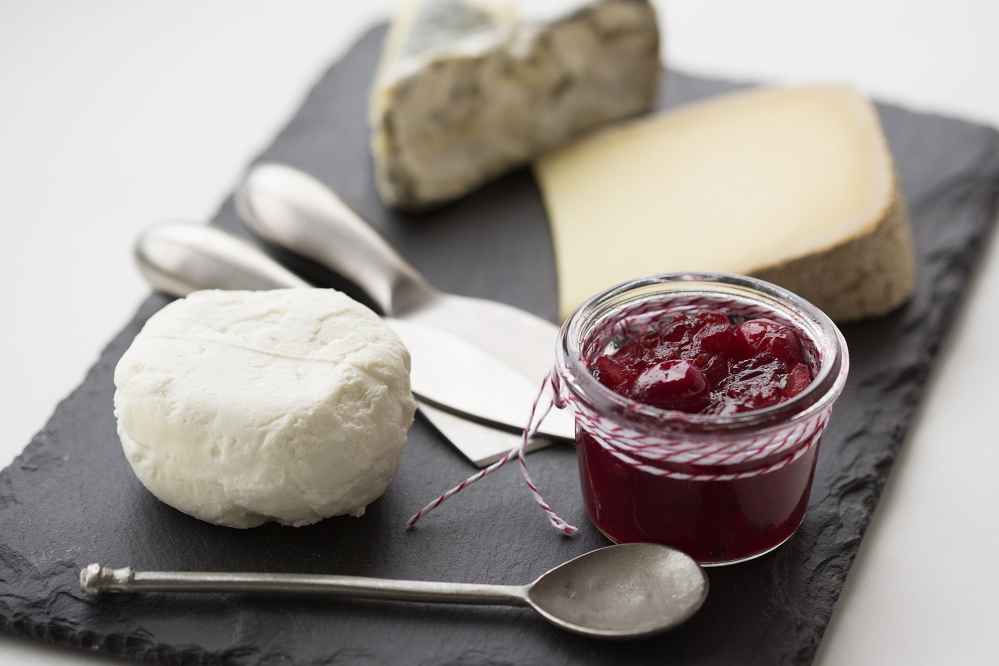As a turophile (hey, look it up!) planning out my holiday cheese plate, I recently read with consternation a report by a Washington, D.C., environmental research organization that found cheese to have the third largest carbon footprint among all sources of protein. It stands behind beef (No. 2) and lamb (No. 1).
The carbon released to transport animal feed, the methane belched by dairy animals, the energy expended to transform a gallon of milk into roughly a pound of cheese, and the fuel used to truck the finished product to stores combine to make the commercial cheese industry a major agricultural contributor to greenhouse gas emissions, the 2011 report by the Environmental Working Group found. For every 2.2 pounds of cheese produced, 29.7 pounds of carbon dioxide equivalents are released into the atmosphere, the report said.
Buying Maine-made cheese – the state has more than 70 registered cheesemakers, so there are plenty of options – obviously cuts down on transportation-related emissions. And Maine Cheese Guild President Eric Rector, cheesemaker and owner of the Monroe Cheese Studio, says there are questions a cheese eater can ask of suppliers to make sure they are buying greener local cheese.
First, question the source of the cheesemaker’s raw material, the milk. Farmstead cheese is made from milk produced on the same farm where the cheese is made. Barring that possibility, closer is better. Rector raises beef cattle, so he sources raw milk for his British-style blue, natural rind Gouda-style and cave-aged cheeses from a farmer who raises Jerseys eight miles down the road.
Secondly, ask what the animals ate.
“There is no set definition for ‘grass-based’ milk production,” Rector said. Most local dairy animals whose milk ends up in cheese are pastured in the summer and are fed hay in the winter, but there is most likely a little grain in the mix as well. Rector suggested asking how much grain the cows are fed and where it comes from, noting that grain shipped from Russia carries a heavy emissions burden.
Rector contends the best place to buy local cheese is at farmers markets because they give producers the best margin, making their businesses more sustainable. That said, there are many retailers that offer local cheeses, including The Cheese Iron in Scarborough, Rosemont Market in Portland, Royal River Natural Foods in Freeport, The Belfast Co-op and Morning Glory in Brunswick.
Three cheeses is the optimal number to include on the plate, according to Rector, so eaters can really experience the differences among them. He suggests buying two ounces each of a hard cheese (something cheddar-like), a stinky cheese (like a blue) and a bloomy soft-rind cheese (something resembling a Camembert) made from a variety of milks (goat, sheep and cow).
Serving cheeses at room temperature brings out their flavors, and pairing cheeses with a chutney made from local ingredients provides a nice counterpoint. This combination will indulge your love of cheese without all the carbon guilt.
JUNE’S CRANBERRY, GINGER AND LEMON CHUTNEY
This recipe is adapted from one that appears in the Cornish (New Hampshire) Cranberry Cookbook by Leigh Callahan and Connie Kousman. The June in the title refers to a high school friend of the authors. The recipe has been handed down for generations in June’s family. The tart cranberries and the spicy ginger and chili combine for a colorful holiday Maine cheese plate.
Makes almost 2 cups
1 medium lemon
12 ounces fresh Maine cranberries (about 3 cups)
2 cups granulated sugar
1/2 cup diced crystallized ginger
1/3 cup finely chopped onion
1 garlic clove, minced
1 teaspoon minced jalapeño chili pepper
1 cinnamon stick
1/2 teaspoon dry yellow mustard
1/2 teaspoon salt
Zest the lemon. Using a small, sharp paring knife, cut away and discard the thick white pith. Cut the lemon crosswise in half and pick out the seeds. Dice the lemon into 1/4-inch pieces.
In a nonreactive medium saucepan, combine cranberries, diced lemon and zest, sugar, ginger, onion, garlic, jalapeño, cinnamon stick, mustard and salt. Add 2 tablespoons water.
Bring to boil over medium heat, stirring often to help dissolve the sugar. Reduce the heat to low and simmer until the sauce is thick and the cranberries have burst, 10 to 15 minutes. Cool completely.
The chutney can be covered tightly and refrigerated. (Alternatively, the hot chutney can be poured into prepared jars and processed in a hot water bath for 10 minutes to be shelf-stable.)
Remove the cinnamon stick just before serving. Serve at room temperature.
Christine Burns Rudalevige is a food writer, recipe developer and tester, and cooking teacher in Brunswick. She writes about feeding her family Maine seafood at www.familyfish.net. Contact her at cburns1227@gmail.com.
Send questions/comments to the editors.



Comments are no longer available on this story